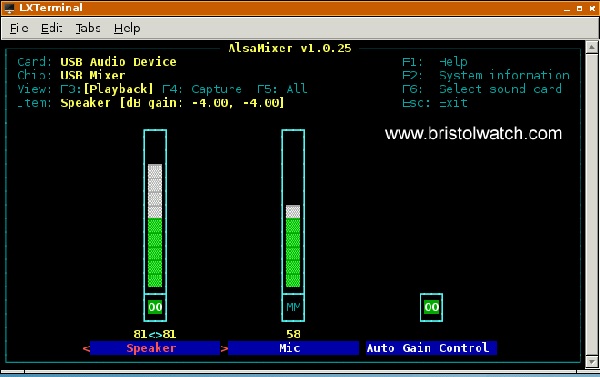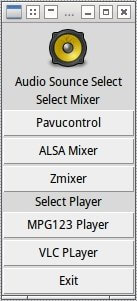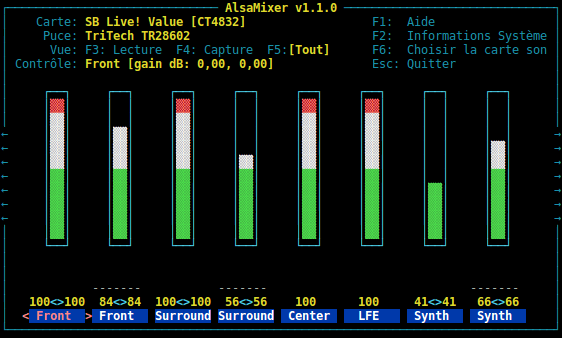
Basics of Alsamixer
by Lewis Loflin
Follow @Lewis90068157
ALSA (Advanced Linux Sound Architecture) is the main Linux sound system. Pulse Audio and Jack operate over ALSA.
Alsamixer is a terminal based sound mixer control. It comes with the system and is useful for trouble shooting or checking sound operation. I use it as another low-resource Linux program.
While one can more on Alsamixer below let us look at a more practical use. Again I'll make a shell script and drop this into my /home/pi/bin directory.

The sample code for the above is audio_select.py
Open a text editor and type the following:
#!/bin/sh
lxterminal -e alsamixer
exit
Save as alsamixer.sh. in your bin directory. Do not save as alsamixer or the system will crash as Linux tries to operate both at the same time.
Make the file executable:
~ $ sudo chmod +x alsamixer.sh
This will make a clickable icon for Rox-Filer, etc. Or simply add to your menu system. My Python menu box above calls shell scripts such as this.

To quote,
Some of the goals of the ALSA project at its inception were automatic configuration of sound-card hardware and graceful handling of multiple sound devices in a system...The sound servers PulseAudio and JACK (low-latency professional-grade audio editing and mixing), the higher-level abstraction APIs OpenAL, SDL audio, etc. work on top of ALSA and implemented sound card device drivers. On Linux systems, ALSA succeeded the older Open Sound System (OSS). Wiki
My Pluggable USB audio adaptor shows up informing me it has been detected and allows on to select audio source and set volume, etc. I have found that just because I select a source doesn't mean it keeps working.
PulseAudio controls underlying ALSA-level volume controls.. To change the ALSA-level volume controls directly, you can do the following:
Open a terminal. (The quickest way is the Ctrl-Alt-T shortcut.)
Enter "alsamixer" and press the Enter key.
You will now see a user interface. In this user interface, you can do the following to quote:
Select your correct sound card using F6 and select F5 to see recording controls.
Move around with left and right arrow keys.
Increase and decrease volume with up and down arrow keys.
Increase and decrease volume for left/right channel individually with "Q", "E", "Z", and "C" keys.
Mute/Unmute with the "M" key. An "MM" means muted, and "OO" means unmuted. Note that a bar can be 100% full but still be muted, so do check for this.
Exit from alsamixer with the Esc key or close terminal.
- Software and setup:
- Raspberry Pi Openbox Desktop 2019
- Setting up Openbox for Raspberry Pi
The Raspberry Pi can be programmed in Python like a Linux PC, or in C. I prefer C.
The operating system is often Debian Linux, which is also used for a Linux PC. The Openbox Desktop is used in both.
- Raspberry Pi Openbox Desktop 2019
- Setting up Openbox for Raspberry Pi
- Sensors using I2C serial connection.
- Interface I2C LCD to Raspberry Pi in C
- ADS1115 4-Channel ADC Uses I2C with Raspberry Pi
- MCP4725 12-Bit DAC Interface to Raspberry Pi
- Using FEH Wallpaper Setter Under Linux
- Add MPG123 Terminal Music Player to Raspberry Pi, Linux
- Basics of Alsamixer Audio Control for Linux
- Tutorial Xinitrc Desktop Manager Control for Linux
- Main Light Fast Linux Desktops with Openbox, JWM
- Test Reuse Surplus PC Power Supplies
- Add WBAR Launch Dock to Raspberry Pi
- Add Solid State Hard Drive to Raspberry Pi
- Beep a PC Speaker Add Beeper to Raspberry Pi
- Scrot Lite Weight Screen Shot Software for Linux
- Using Light Weight Beaver Text Editor
- Install Viewnior Image Viewer for Linux
- Zmixer ALSA Sound Control Tutorial
- Setup Raspberry Pi Using JWM Window Manager
- Live Linux Distro for Using Printer Port with Electronics
- Using the powerful Rox-Filer system in Linux
- Use FEH under Linux for a Wallpaper Setter
- How to create Symbolic links in Linux
- Exploring Digital Computer Electronics
- Hardware
- Hardware Review Connecting PC Parallel Ports
- Operation TB6600 Stepper Controller with PC Parallel Port
- Build or Buy Parallel Port Breakout Board?
- Build Serial HD44780 LCD Display Connect to Parallel Port
- Motherboards
- Presario 1999 CM1001 Gaming Computer Salvage
- Live Test 2002 VIA EPIA-800 Mini ITX Motherboard
- Salvage, Test 2012 AAEON EMB-B75A Industrial Motherboard
Web site Copyright Lewis Loflin, All rights reserved.
If using this material on another site, please provide a link back to my site.
